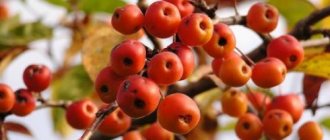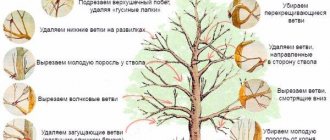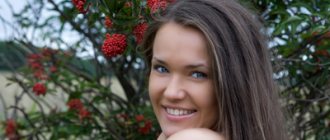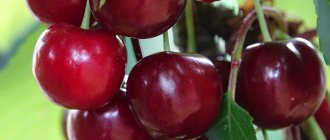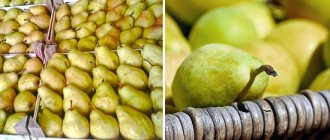How to understand rowan trees?
Our common, ubiquitous red rowan belongs to the large botanical genus Sorbus . In turn, almost all modern cultivated varieties trace their ancestry from this plant.
More precisely, from its two varieties-varieties: Moravian (Central Europe) and Nevezhinskaya (Eastern Europe).
Moravian rowan was discovered in the Czech Republic in the 19th century and was named after the region where it was found - Moravia. Its sweet fruits, 1 cm in diameter, made this variety interesting for breeders.
From it came, for example, the varieties Edulis, Bissneri and Concentra.
Almost all modern cultivated varieties trace their ancestry to two varieties of mountain ash - Moravian and Nevezhinsky.
The Nevezhinsky clone was also found by accident - in a forest near the village of Nevezhino, Vladimir region. The sweet, completely without bitterness fruits captivated the local peasants, who quickly figured out how to grow this rowan and sell the seedlings to their neighbors.
And this also happened in the 19th century. So almost instantly, in two ends of Europe, nature gave man a sweet rowan instead of a bitter one.
Sometimes Nevezhin rowan is called “Nezhinskaya” . Everyone was confused by the wine merchant Fyodor Smirnov, who in the old days sold tincture made from its fruits. Not wanting to reveal the secrets of the recipe to his competitors, he deliberately dropped one syllable and named his product “Nezhinskaya”.
Ivan Vladimirovich Michurin was very interested in breeding varietal rowan trees. Many of the varieties he created today have either been lost, or have been pollinated and lost their original characteristics, or are stored only in scientific collections. But those that have survived often become the basis for modern breeding work.
From a strictly scientific point of view, calling rowan fruits “berries” is incorrect. It's correct to say "apple". Fruits of the same type are formed by quince, apple and pear.
Titanium
This variety is one of the surviving Michurin creations . It was created by complex crossing of rowan, pear and red-leaved apple tree.
Its characteristics:
- A medium-sized tree (up to 5 meters) with a rounded, sparse crown. The shoots are straight, the bark color is dull brown.
- The leaves are glossy, dark green.
- The inflorescences are shields of medium diameter, the color of the petals is white.
- The fruits are slightly ribbed, round, weighing 1.2 grams. The skin is dark red, waxy. The pulp is yellow, sweet and sour, tart. Universal use.
The Titan variety is frost- and drought-resistant and is not affected by diseases.

The rowan variety Titan was bred by Michurin, it is frost- and drought-resistant, and is not affected by diseases.
| Chemical composition of fruits | |
| Sugar | 10,2% |
| Organic acids | 1,4% |
| Vitamin C | 33 mg/100 g |
| Dry matter | 20% |
Bead
The variety was created by Candidate of Agricultural Sciences Tatyana Kirillovna Poplavskaya . Fanatically devoted to science, in the 70s of the 20th century she was actively involved in the search and restoration of lost Michurin varieties of mountain ash.
Businka is one of the first varieties that does not have a hint of astringency. It is a product of free pollination of Nevezhin rowan.
Characteristics and description of the variety:
- Plant of moderate growth, 3 meters high. The shoots are gray-brown, straight. According to various sources, it begins to bear fruit at the 3rd or 5th year of life.
- The leaves are light green, serrated.
- The inflorescences are large, with white flowers.
- The fruits have a regular round shape, with red skin, weighing 1.2-1.9 grams. The flesh is cream-colored, with a hint of cranberry flavor, but without strong acid. The purpose is universal. They ripen early, by the end of August.
Particularly valuable advantages of the variety are its high resistance to extreme frosts, drought, and diseases. Productivity is high.
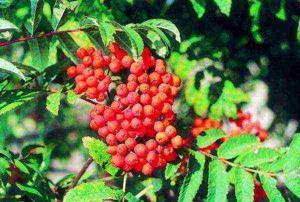
The rowan variety Businka is not astringent and is highly resistant to extreme frost, drought, and disease.
| Chemical composition of fruits | |
| Sugar | 10% |
| Organic acids | 2,2% |
| Vitamin C | 67 mg/100 g |
| Carotene | 9 mg/100 g |
| Dry matter | 25% |
Rowan - botanical information
The genus Rowan (Sorbus) is represented mostly by small deciduous trees 10–20 meters high, although some species are shrubs. Representatives of the genus grow mainly in regions of the Northern Hemisphere with a temperate climate. The highest species diversity can be found in the Himalayas, southern Tibet and parts of western China.
In the middle zone, the most common mountain ash (Sorbus aucuparia) is found. This is a very variable species, but typically the trees have the following appearance: a tree with a thin trunk and smooth bark. The bark of young trees is yellowish-gray and shiny; in maturity it becomes gray-black with longitudinal cracks. The crown is loose, round in shape. The leaves are compound pinnate. It blooms from May to June with dense shields of small yellowish-white flowers with a noticeable specific aroma.
After flowering, orange-red fruits set, which ripen from August to October and are readily eaten by many species of birds. The plant is undemanding, frost-resistant, and inhabits abandoned and hard-to-reach places. Rowan rarely survives the age of 80 and is one of the shortest-lived trees in temperate climates.
Liquor Michurina
One of the Michurin varieties , lost and restored. It has a lot in common with one of its “parents” – chokeberry.
Characteristics of the garden variety of rowan:
- A medium-sized plant, about 5 meters, with a sparse oval crown. Sometimes found in bush form. Gives strong annual growth (up to 30 cm).
- The leaves are dark green, alternate, imparipinnate.
- Beautiful dense inflorescences with a scutellum diameter of 10 cm. The color of the petals is white and pink.
- The fruits are dark purple, almost black, weighing 1 g, ripen in September, and are stored for a month. The taste is reminiscent of chokeberry - sweet, slightly astringent. Purpose: for making liqueur-type wines and jams.
Advantages of the variety: high winter hardiness and moderate drought resistance. Disadvantage : fruits may be affected by rot.

Rowan of the Lickernaya variety was bred by Michurin, excellent for making liqueur-type wines and jams
| Chemical composition of fruits | |
| Sugar | 10,8% |
| Organic acids | 1,3% |
| Vitamin C | 15 mg/100 g |
| Carotene | 2 mg/100 g |
| Cellulose | 2.7 g/100 g |
Is the mountain ash edible?
Rowan berries are relatively edible, since they are undesirable to eat raw (especially in large quantities), because they have a strong astringent, diuretic (up to kidney damage) and laxative effect due to the high level of parasorbic acid. By the way, it is this acid that gives the fruits a specific bitterness.
However, after cooking (heat treatment, drying) or freezing, the berries become sweeter. Therefore, it is better to collect them after the first frost (for a similar effect, the berries can also be placed in the freezer).
Rowan berries contain vitamins A (even more than carrots) and C (more than red currants), as well as other beneficial substances, such as pectin, malic acid and tannins. Traditionally, the berries were used to prevent scurvy and treat gout, colds, flu and rheumatism.
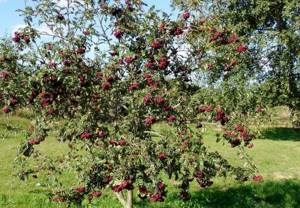
Sweet-fruited rowan. © Favorite Garden
Ruby
The Michurin variety was also lost, but was found, propagated and transferred to T.K. Poplavskaya for variety testing. Like all old Michurin forms, this type of rowan has a slight astringency in taste .
Its characteristics:
- A low tree, 3 meters in height, with a drooping crown. The skeletal branches are located almost at right angles, the shoots are straight, with light brown integuments.
- The leaves are light green, with a finely serrated edge and a pubescent petiole.
- The scutellum is not wide, the flowers are small, pinkish-white.
- The fruits are rounded and flattened, weighing 1.3 g. The skin is ruby-colored, the flesh is yellow. The taste is sweet and sour, slightly tart. The purpose of the fruit is for processing into juices, jellies, wines, liqueurs, jelly. Suitable for drying.
The plant is resistant to low temperatures.
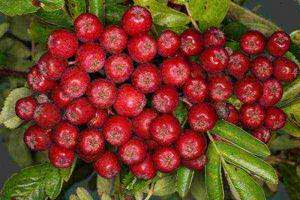
Rowan of the Rubinovaya variety is good for processing into juices, jellies, wines, liqueurs, jelly
| Chemical composition of fruits | |
| Sugar | 12,4% |
| Organic acids | 1,3% |
| Vitamin C | 21 mg/100 g |
| Anthocyanins | 948 mg/100 g |
Rowan fruits of the Rubinovaya variety can replace raisins after drying. To do this, you need to place them in a gauze bag and hang them by the radiator for a while.
Scarlet large
A variety bred by the Central Genetic Laboratory named after. Michurin (today the All-Russian Research Institute of Genetics and Selection of Fruit Plants). An interesting, very impressive plant, with really large fruits for a red rowan.
Variety characteristics:
- The height of the tree is 5 meters. The crown is of medium density, wide-pyramidal in shape. Slightly pubescent straight shoots with gray-brown bark and many large lentils.
- The leaves are dark green, with broadly lanceolate plates, shiny.
- Wide corymbs with many flowers.
- Fruits are from 1.7 to 2.5 grams, slightly ribbed, juicy. The skin is scarlet in color, the taste is piquant, somewhat sour than other varieties, without bitterness. Purpose: table and technical.
The variety is able to tolerate extreme frosts down to -50⁰C. Resistant to diseases and pests .

Large scarlet rowan can tolerate extreme frosts down to -50⁰С
| Chemical composition of fruits | |
| Sugar | 8,4% |
| Organic acids | 1,9% |
| Vitamin C | 21 mg/100 g |
| Anthocyanins | 625 mg/100 g |
How to care for rowan
Caring for rowan trees is easy. The tree trunks are kept in order: they are weeded and loosened. In grafted plants, root shoots and shoots developing below the grafting site are cut out. Only young specimens need watering, and only during hot, dry periods. In autumn, tree trunk circles are covered with nutritious compost and rotted manure.
Rowan trees respond well to crown molding. To do this, shoots damaged over the winter and weak ones are removed in early spring. Excessively long shoots are shortened by removing the upper internode. If there is a significant deterioration in growth and fruiting, pruning wood to 2-3 years old helps.
White, yellow and orange decorative varieties
In addition to the familiar red and chokeberry rowans, through the efforts of breeders, varieties with yellow, orange and even white fruits have been developed that can decorate any garden.
For example, the Yellow variety has thin flexible branches that bend to the ground when the harvest is abundant. Its fruits are used to make rowan kvass, original fillings for pies, and jams.
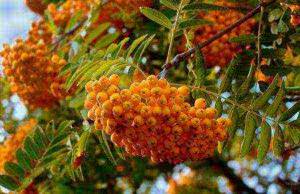
The Yellow rowan variety is good for making kvass, jam, and as a filling for pies.
Of the orange-fruited varieties, the Ogonyok variety - one of the most heat-resistant and drought-resistant. As it ripens, it changes the color of the apples from yellow to fiery orange.
Rowan Daughter of Kubova is a new variety bred through spontaneous hybridization of the Nevezhinskaya Kubova. The fruits of this tree also have a bright orange color in the ripe phase, and their taste is juicy, bright, sour-sweet, without a hint of bitterness or astringency.
Kubova herself also has orange fruits, but the yield is not so high. Kubovaya is a derivative form of the Nevezhin rowan, created through folk selection. Its apples are slightly elongated, pentagonal, with a very pleasant taste.
But white-fruited mountain ash, unfortunately, is not suitable for food. For example, the Quene or White Swan varieties have very bitter fruits . However, their compactness and high decorative value make it possible to create an interesting play of colors among other rowan trees.
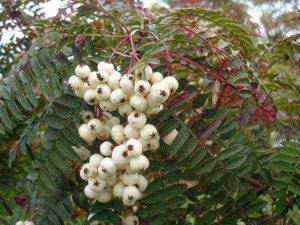
Decorative white-fruited mountain ash varieties Kene or White Swan are not suitable for food
By combining, for example, tall large Scarlet, delicate Yellow and miniature White Swan in plantings, you can get a combination of benefits and beauty.
All varietal rowan trees are self-sterile. To get a high-quality harvest from them, you need to plant several different varieties nearby or graft them into the crown of one tree.
Rowan is one of the most frost-resistant fruit trees. More than a hundred species of mountain ash are known, and about a third of them can be seen in Russia. Breeders have developed many promising varieties that differ in color, size and shape of the fruit. There are two known subgenera of rowan, differing in leaf shape. Representatives of the rowan subgenus are of greatest interest. It was they who gave rise to varieties of garden rowan and it is their fruits that have nutritional and medicinal value. The second subgenus underlies the decorative varieties. The berries of edible rowan varieties are harvested in August-September. It takes up to 90 days to reach technical maturity. The rate of ripening directly depends on weather conditions and the growing region.
Chokeberry is a self-pollinating plant. Even if only one bush grows in the garden, it will bloom and bear fruit. Growing a bush from seeds is the longest, but simplest. Seeds are squeezed out from ripe berries, dried and stored in a dark place. Seeds are sown in the ground in autumn (from September to October) or spring.
Rubina
The variety has increased resistance to diseases and is unpretentious in care. Loves sunny areas. The berries are slightly tart. The variety is highly resistant to pests and diseases, and frost-resistant. Rowan blooms in early June. The berries ripen in September and have a round shape with a diameter of up to 1 cm. It is recommended to plant seedlings in the fall.
Nero
Suitable for growing in climatic regions with harsh winters, as well as in shaded areas. The fruits contain an increased amount of vitamins. The variety produces delicious berries and is a real decoration for the garden plot. The height of the plant does not exceed 2 m. The shape of the crown resembles a vase. White flowers have red stamens, which adds decorativeness.
Black-eyed
It has increased resistance to diseases; mountain ash is easy to care for. Loves sunny areas. The berries are not tart, unlike other varieties. The “Chernookaya” variety differs from others in the reduced astringency of its berries. It blooms in early June and is a honey plant. The berries ripen in September, have a round shape, and reach 1 cm in diameter. It is recommended to plant seedlings of the Chernookaya variety in the fall.
Aronia Michurina
Tree more than 3 m high with a dense oval crown. It has obovate leaves with an oval tip; this shape is slightly variable. The fruits are large, weighing up to 1.5 g, spherical, slightly flattened, black with a bluish matte coating. They are juicy, edible, sweet and sour taste with tartness. "Aronia Michurina" can withstand winter temperatures down to -40°C.
Viking
A small shrub with dark green leaves with jagged edges. The variety blooms in May. The purple-black berries, slightly less than 1 cm in diameter, have a flat-round shape and ripen in the fall. The variety is characterized by productivity and frost resistance. For planting seedlings, choose sunny areas; preference is given to loamy or soddy-podzolic soils with a neutral environment.
Hugin
Shrub up to 2 m tall with a characteristic rounded crown. Planting seedlings is recommended only after the last frost. The leaves are dark green and shiny. Flowering is shifted to June. White flowers form lush inflorescences. Large black and red berries ripen in September. The plant is winter-hardy. One of the features is intolerance to heavy pruning.
Red rowan is a fruit tree with bright red berries that can remain on the branches from summer to late autumn and even all winter until spring. Rowan fruits contain many acids: citric, malic, sorbic, tartaric and succinic. In addition to acids, rowan fruits contain up to 5% sugar, carotene, bitter and tannins, and ascorbic acid.
Grenade
The variety combines the advantages of rowan and hawthorn. The plant is low, winter-hardy, and very decorative. The fruits are burgundy and large – they are similar in size to cherries. The taste is sweet and sour, the yield is high.
Bead
A medium-sized tree, about 3 m high, with a rounded crown of medium density. Tree of moderate growth. The fruits are round, red, weighing up to 2 g. The pulp is creamy, very juicy, medium density, sweet and sour taste without bitterness or astringency. Productivity is high. Transportability is good. The fruits can be consumed fresh. The variety is sun-loving, resistant to frost and disease.
Ruby
Medium ripening variety. The tree is medium-sized, up to 3 m high. The crown is medium dense, drooping. The fruits weigh 1.3 g on average, are one-dimensional, flattened, with a smooth, wide-ribbed surface, ruby in color. The pulp is yellow, medium density, juicy, sweet and sour. The variety is resistant to low temperatures. The fruits are recommended to be used dried as dried fruits for compotes.
Scarlet large
Medium-late ripening variety. Tree of moderate growth, up to 6 m high. The crown is of medium density, regular wide-pyramidal in shape. Fruits with an average weight of 1.7 g, one-dimensional, cylindrical, flattened, with a cup, with a smooth, slightly ribbed surface, regular shape and scarlet-red color. The taste is sweet and sour, with a spicy rowan flavor. The variety tolerates frosts down to -50°C.
Titanium
The tree is medium-sized, with a rounded crown of medium density. Height is about 5 meters. The crown is sparse, forms well naturally, and requires only minor thinning. The variety is early-bearing and yields annually. The fruits weigh an average of 1.2 g, are round, slightly ribbed, with a straight, medium-sized stalk. The color is dark cherry, with a waxy coating. The pulp is intense yellow, medium density. The taste of the berries is sweet and sour with a slight tartness. Trees are resistant to adverse environmental factors: frost, drought, disease.
Ogonyok
Variety of early autumn ripening, universal use. The tree is medium-sized, with a rounded crown of medium density. The color of the fruit during ripening is yellowish-orange, when ripe it is red-orange. The pulp is yellow, medium density, loose, fine-grained, very juicy. The taste of the fruit is sweet and sour, with a weak aroma. The variety is winter-hardy, heat resistance and drought resistance are high. Resistance to pests and diseases.
Rowan ranks among the first among fruit plants in terms of winter hardiness. It tolerates very harsh winters quite well with temperatures down to minus 50°C. It blooms late, which avoids damage by spring frosts. Most varieties of sweet-fruited rowan have a sweet dessert taste. They lack the astringency inherent in wild mountain ash. This means that varietal rowan can be eaten fresh in large quantities, and also made into delicious jam, jam, marmalade, wine, and tinctures; The fruits can be wetted and dried. Rowan fruits are very rich in carotene, rare vitamin K1, vitamins C and P.
Burka
A complex hybrid of alpine sorbaronia and mountain ash. It begins to bear fruit at 2-3 years of age. The tree is short, 1.5–2.5 m. The crown is compact. The leaves are simple, odd-pinnate. The variety is highly winter-hardy. The yield is annual and stable; 40–60 kg of berries can be harvested from 1 plant. The taste is only slightly inferior to Dessert. The fruits are medium-sized, red-brown, slightly tart. Stores well for 3-4 months.
Scarlet large
Medium-late ripening variety. Tree of moderate growth, up to 6 m high. The crown is of medium density, regular wide-pyramidal in shape. Fruits with an average weight of 1.7 g, one-dimensional, cylindrical, flattened, with a cup, with a smooth, slightly ribbed surface, regular shape and scarlet-red color. The taste is sweet and sour, with a spicy rowan flavor. The variety tolerates frosts down to -50°C.
Bead
A medium-sized tree, about 3 m high, with a rounded crown of medium density. Tree of moderate growth. The fruits are round, red, weighing up to 2 g. The pulp is creamy, very juicy, medium density, sweet and sour taste without bitterness or astringency. Productivity is high. Transportability is good. The fruits can be consumed fresh. The variety is sun-loving, resistant to frost and disease.
Grenade
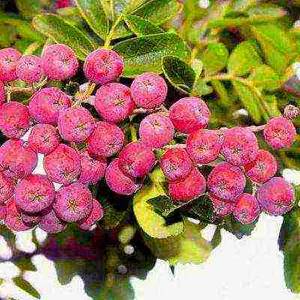
The variety combines the advantages of rowan and hawthorn. The plant is low and very decorative. The variety is winter-hardy, productive, with the largest fruits the size of burgundy cherries. The taste of the berries is sweet and sour.
Wefed
Rowan Vefed - medium ripening period. The tree is medium-sized, with a rounded, sparse crown, up to 4 m high. The fruits weigh an average of 1.3 g, one-dimensional, regular in shape, rounded and pointed towards the base. The color of the fruit is elegant, pink-red. The pulp is yellow, tender, sweet and sour, pleasant when eaten fresh. It is characterized by stable fruiting, which begins in 3-4 years. The harvest ripens in the second half of August. Winter hardiness is high, relatively resistant to diseases and pests.
Sorbinka
A variety of mid-autumn ripening, universal use. The tree is medium-sized with an obovate crown of medium density, the height of the tree is up to 6 m. It begins to bear fruit in the 4th year. The fruits are round, red, weighing up to 2.7 g. The pulp is yellowish, juicy, sweet and sour taste without astringency or bitterness. Location: in the sun. The variety is winter-hardy, highly adapted, resistant to pests and diseases.
Dessert Michurina
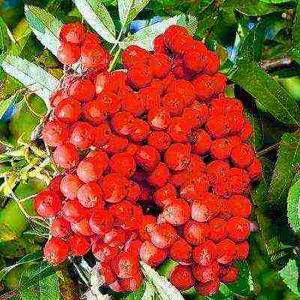
Miracle berry. A small tree with a height of 1.4-1.8 year after year pleases with abundant and lush flowering in the spring, and in the summer at the end of July - August it lights up with a multitude of large ruby (up to 1.5-2 g) edible berries with a pleasant sweetish-tart taste. Used as a source of vitamins, organic acids, biologically active substances and minerals in fresh form, in compotes, teas.
Liqueur Michurina

Tree up to 5 m high, with a sparse crown. The fruits are large, up to 15 mm in diameter, almost black, with dark-colored juice. The pulp is juicy, practically without tartness, and quite sweet. It begins to bear fruit 4–5 years after planting. Blooms in late May - early June. The fruits ripen in mid-September. Productivity and winter hardiness are high. May be severely affected by rot. Fresh fruits can be stored for up to 1 month. The variety requires cross-pollination to bear fruit. The best pollinating varieties: “Burka” and “Nevezhinskaya”.
Daughter of the vat
Variety of early autumn ripening, universal use. The tree is medium-sized with a paniculate sparse crown. It begins to bear fruit in the 5th year. The fruits are oblong, bright orange, weighing up to 2 g. The pulp is bright yellow, without astringency and bitterness. Rowan bears fruit annually and produces up to 90 kg of fruit per tree. Ripening date is mid-August. They are used fresh and for a wide variety of preparations. Prefers loose soils and does not tolerate waterlogging.
Sugar Petrova
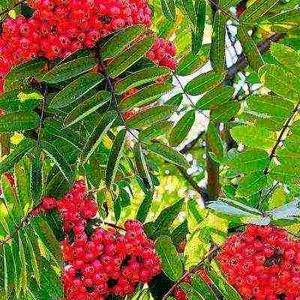
This is a very rare variety of sweet-fruited rowan. It was almost irretrievably lost, but breeders managed to find it and propagate it. This rowan is the sweetest, it really is sugar. When at the end of October the garden is already completely empty, and there seems to be nothing to sweeten the chilly autumn day, you will unnoticed, handful by handful, put berries of this magical variety into your mouth. And amazing grace will spread throughout your chilled body, life-giving sweetness will quickly restore your strength.
Nevezhinskaya
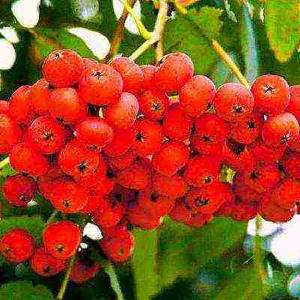
A variety of folk selection. The trees are tall, with a wide-rounded crown. The berry ripening period is late August - early September. Medium sized fruits. The taste is good, sweet and sour. The color of the fruit can vary from red to orange. The fruits of Nevezhinskaya are juicy, completely without astringency, and very rich in biologically active substances. In terms of vitamin C content, its fruits can be compared to lemons. The best pollinator is Bead.
Solar

A very elegant, beautiful variety with bright orange, cherry-red, oblong fruits weighing 1.8 g. The taste is very pleasant, without astringency or bitterness. Ripens in mid-August. The use is universal, the “storehouse of vitamins” will find use everywhere. Tree of moderate growth, winter-hardy.
Moravian
The plant has a pyramidal crown. The ellipsoidal berries are raspberry-colored. They are very sweet, with a slight note of acidity, without the specific rowan astringency.
Many varieties of rowan look very beautiful in the garden. Plants with unusual berry colors and beautiful clusters are of great interest.
Wefed
A tree of medium height with a round, sparse crown, reaching a height of 4 m, with elongated, matte, dark green leaves. The fruits of the Vefed rowan are of regular shape, round, but pointed towards the base, with a medium-sized stalk, pink-red in color without subcutaneous points and yellow, sweet and sour pulp. The berries contain 96 mg of vitamin C and 32 mg of carotene. Fruiting begins in the 4th year. This dessert variety is frost-resistant and disease-resistant.
Burka
A complex hybrid of alpine sorbaronia and mountain ash. It begins to bear fruit at 2-3 years of age. The tree is short, 1.5–2.5 m. The crown is compact. The leaves are simple, odd-pinnate. The variety is highly winter-hardy. The yield is annual and stable; 40–60 kg of berries can be harvested from 1 plant. The taste is only slightly inferior to Dessert. The fruits are medium-sized, red-brown, slightly tart. Stores well for 3-4 months.
How to deal with pests and prevent their occurrence? (table)
| Pest name | Description | Fighting method | Prevention method |
| Pests that damage leaves | |||
| Cherry slimy sawfly | Dangerous pest of chokeberry. An adult insect has shiny black wings, its length is 5 mm. The larva is comma-shaped and covered with dark, thick mucus. A massive emergence of larvae is observed at the end of July; they feed on the pulp of the leaf from the outside. They are able to gnaw off the entire leaf, leaving only the veins. They parasitize on chokeberry for a month, then go into the soil under the host tree. | It is recommended to use solutions:
Spraying the chokeberry bush is carried out the first time after flowering, then two more times with an interval of 1 week. Stop spraying a month before harvest, only using a solution of soda ash is allowed. | Digging up the soil around the trunk to at least 15 cm in the autumn, loosening the row spacing. |
| Scoop caterpillars | The armyworm is a nocturnal moth about 1 cm long; their mass emergence begins in May; a week later they lay eggs on the inside of the leaves of cultivated plants and weeds. The emerging caterpillars are very voracious, operate in the evening and at night, and are capable of gnawing 20 young leaves. They are 3 cm long. They spoil the berries by making holes in them. For the winter they go into the soil and pupate. | Spraying is carried out at the end of May. Use:
|
|
| Moths | An adult insect is a nocturnal butterfly with a wingspan of 2.5 cm. A caterpillar is 2 cm long. They appear before flowering, nibble on leaf plates, buds, and flowers. After flowering, they go into the ground to a depth of 10 cm, pupate, in October butterflies fly out and lay eggs under the bark of the trunk and branches for the winter. | Before flowering, rowan is sprayed with cyanox, zolon, karbofos, chlorophos according to the instructions. Before the buds from the eggs open, you can spray the rowan with nitrafen. | In early spring, treat the trunks with copper sulfate (100 g per 10 liters of water). |
| Belyanki | The adult insect is a white diurnal butterfly with one black spot on the wings. Wingspan 5 cm. Flights in May, lays from 50 to 200 eggs. The caterpillar is thin, up to 4 cm long, gnaws leaves down to the skeleton. Pupates on fences, trunks and branches of mountain ash. At the end of summer, the second generation of butterflies appears. | Spraying is carried out at the end of May:
|
|
| Spider moth | This is a small white butterfly, 2 cm long, with a velvety sheen, and lays eggs on the smooth branches of rowan trees. The caterpillars are yellow with a brown head and cover the leaf with cobwebs. At the end of May, the caterpillars move to the top of the tree, continuing to weave webs around the leaves. Damaged leaves dry out and fall off. |
| Collection of browned young leaves and leaves entangled in cobwebs. Everything needs to be burned. |
| Rowan mite | It overwinters in fallen rowan leaves, feeding on their juice. Over the summer it can produce 4 generations. At the end of May it forms galls on both sides of the leaf. Gall mite is a serious cause of crop decline. | During the period from the appearance of the first leaves to the beginning of flowering, spray the rowan with colloidal sulfur (100 grams per 10 liters of water). | Remove fallen leaves. |
| Pests that attack flowers | |||
| Weevil beetle | The small brown beetle overwinters in bark cracks and fallen leaves. When the temperature is not lower than 10 degrees, it settles in trees. First, the insects feed on the buds, eating the core out of them, and then lay an egg in the bud. The larva hatches and begins to gnaw on the bud, the petals stick together and dry out. Then the young beetles move onto the leaves and gnaw holes in them. |
| Treat the bark and branches with a solution of copper sulfate (100 grams per 10 liters of water). |
| Pests that damage flowers | |||
| Rowan moth | Small butterfly, wingspan - 1.5 cm. Damages rowan berries. The caterpillar is yellow with a dark head. During the initial stage of fruit set, the moth lays an average of 50 eggs, the larvae bite into young berries, make winding passages, in the fall they go into the soil to a depth of 10 cm to pupate, and overwinter in the surface layers of the soil under fallen leaves. | At the end of June, rowan must be treated with chlorophos (20 g per 10 liters of water) | Digging around the tree trunk, collecting and burning fallen berries and leaves. |
| Apple fruit sawfly | An insect 6 mm long is brown in color with transparent wings, the larva is 1.5 cm long yellow, wrinkled, shiny. The female lays eggs in flowers with future ovaries. | 10 grams of white mustard powder is poured into a liter of water and left for a day, then diluted with water 1:5 and sprayed on rowan. | After the end of rowan flowering, loosen the soil around the trunk to a depth of at least 10 cm. |
| Pests of bark and branches | |||
| Shchitovka | The body is covered with a waxy shield; the larvae are up to 5 mm in size and feed on plant sap. |
| Timely thinning of the rowan crown, pruning and destruction of heavily infected branches. |
| Bark beetle | A small dark-colored beetle gnaws holes in the bark, making its way closer to the succulent wood. All stages of life take place in the cortex. | The drugs used are: Lepidocid, Aktara, Confidor. Spray rowan after flowering, repeat the procedure after 2 weeks. The entire tree should be treated - trunk, branches and leaves. | Regularly loosen the soil around the tree trunk. |
Photo gallery: pests of red rowan and chokeberry
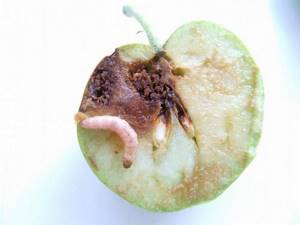
The apple fruit sawfly can spoil more than half the harvest

The rowan moth is dangerous due to its massive invasion; it can destroy almost the entire crop.
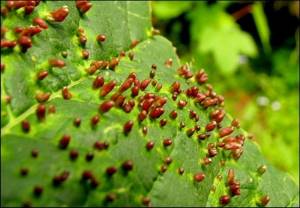
Galls on the leaf look like numerous warts
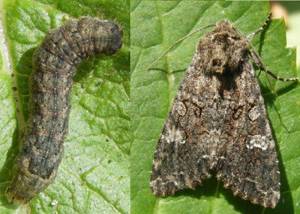
Cutworms are voracious caterpillars that can eat up to 20 leaves per day.
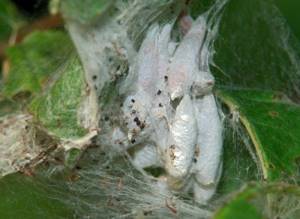
If the rowan tree is severely damaged, the spider moth can entangle the entire tree in a web.

Slimy sawfly larvae feed on the upper leaf tissue

Caterpillars eat leaves down to the veins, thereby reducing the amount of harvest
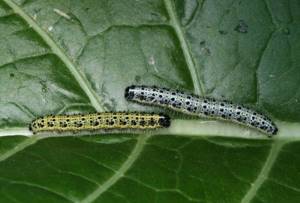
White butterfly caterpillars pupate on tree trunks and branches
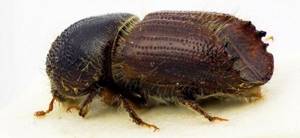
The bark beetle creates entire megacities under the bark, slowly destroying the wood and causing the death of the tree
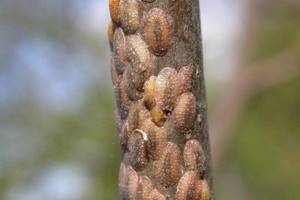
Scale insects are a very dangerous pest, which is quite difficult to combat.
To avoid infection of rowan with certain diseases, it is better to choose more resistant varieties from trusted nurseries, follow simple preventive measures, and care for the seedling and grown tree. All of the above diseases and pests are dangerous for both red rowan and chokeberry. This does not mean that they will all find themselves in the garden plot. Forewarned is forearmed.
- Author: Maria Osmis
Rate this article:
- 5
- 4
- 3
- 2
- 1
(5 votes, average: 3.4 out of 5)
Share with your friends!


